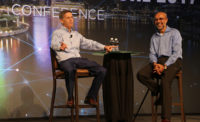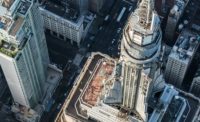Construction is a wonderful subject for serious photography. It literally roars with rapidly changing activities that can yield eternally powerful images.
Jobsites are intense with huge forces at play. Great masses are in balance, held just so by human wit and skill as structures are drawn from patterns and colors of massed supplies. Creations rise majestically through the glowing light of ever- changing days.
And everywhere there are the people who conceive and manage the projects, whose hands set the brick, weld the steel, screed the mud and drive the nails. In photos they forever give witness to the fact that every piece of the built world was imagined by human mind, placed by human hand.
Construction photographer Michael Goodman, a 20-year veteran of the specialty who has published hundreds of images in ENR, refers to it as “the magic process of construction.” He believes the best construction photos often revolve around the people at the heart of the work. Editors, art directors and others in the field agree.
“It’s a tough thing to define, but you know it when you see it,” says Terry Lowenthal, a shooter and the photo editor for Bechtel Corp.’s internal employee publication.
Lowenthal says photographers who consistently deliver superior images not only find interesting light and angles, they also forcefully convey scale. And if there are people at work, they are invariably at the peak of action. “It’s like sports photography,” she says. “Find that moment that captures the action.
“We focus not only on getting dramatic pictures of the things we build, but also on the people creating these incredible things,” adds Lowenthal. “We don’t just photograph completed projects. In fact, we mostly photograph projects in progress. It’s important to show how they are built. It gives people who are not engineers an appreciation of what goes into something like the building of a powerplant, a dam or railroad.”
Whether digging through archives that go back 127 years or studying the best new work of photographers today, ENR Art Director Guy Lawrence says it is remarkable how often the same qualities emerge in the most arresting images. Aside from the basic high standards of sharp focus and correct exposure, almost all the great shots are built around people. The framing is dramatic and the pictures often depict workers in the midst of scenes seething with the restrained energy of looming mass and machines. The implication is one of skillfully managed risk, even danger, and the effect is frequently awesome.
Lawrence says the best images convey an intensity about the individuals engaged in their work. In some of the most compelling ones, there suddenly comes a secondary recognition that the unseen photographer is mysteriously perched somewhere that may be even more remarkable than the position of the people depicted in the scene.
“Sometimes you’ve got to go to some pretty outrageous places,” Goodman acknowledges. “I don’t try to do dangerous things, [but] that’s part of that moment—you being in the right place at the right time.” Goodman says good work often starts with getting inside the fence and closing in on the action. “Up close and personal is how to shoot it. Get right in there with it.”
Good photographers shoot many images and vary the composition. Opportunities are dear and film is cheap. Editors point out that interesting work is not necessarily the same thing as an interesting image. When the work gets intense, that’s the time to shoot, not when it’s over and the handshakes are going around. Think about the image in the frame and consider the light. Sometimes early and late sun will vastly enhance otherwise mundane scenes.
Photographers should study the job and collaborate with the builder. Because sites are often closed and can be dangerous, construction photography calls for shooters who understand the work. The best shots require cooperation between builder and photographer.
“Our feeling is that construction photography, particularly tunneling, is a team game,” says James Byrne of QA Photos, Folkestone, Kent, England.
Byrne collaborated with Diana Craigie to capture the essence of the boring of the Channel Tunnel linking England and France. “Our best photos are a small tribute to all those amazing construction people building all those wonderful structures who believed in us, helped us, kept us safe and cared enough to make the effort on our behalf,” Byrne says.
Like the tunneling image, forceful photos yank the viewer into another time and place and drive the mind to analyze and contemplate. “What I like about [the photo] is that when miners look at it they say they can smell the tunnel. And when I look at it I can feel the grit in my teeth. I can taste the tunnel,” says Craigie.
Great pictures do much more than please the eye. Great shots hijack our minds and take us away.





Post a comment to this article
Report Abusive Comment